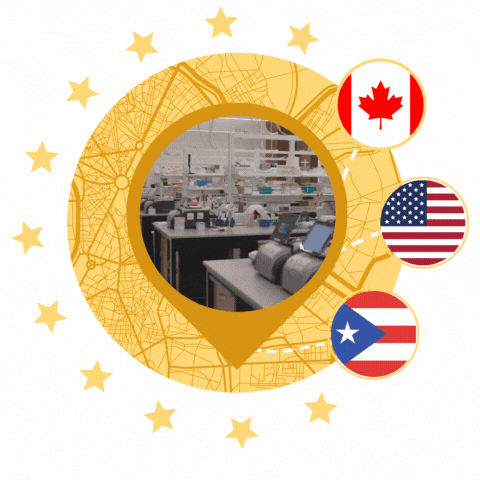
César Bertinetti
Torres-Dowdall Lab
University of Notre Dame, Indiana

Abstract
My research focuses on the molecular mechanisms that enable fish to adapt their color vision in response to changes in water clarity. Given the current anthropogenic threats aquatic ecosystems experience, understanding how and why certain fish species might be more able to succeed than others is key to informing ecosystem management and predicting evolutionary outcomes. My research combines field ecological measurements and molecular lab techniques to understand how ambient light conditions impact the diversity of visual systems seen in freshwater fish and their performance in different environments. Specifically, I focus on genomic signatures (e.g, protein sequence divergence, population structure) and gene expression analysis (e.g., RT-qPCR, RNA-Seq) to understand the underlying molecular mechanisms involved in diverse visual systems.
Currently, my work compares the contrasting patterns observed between invasive and native freshwater fish in North American water bodies. For this, first I characterised the diversity and variability of visual systems in sunfishes, a native group of fishes of economic and ecological relevance (e.g., largemouth bass, bluegill, crappie). My work revealed that color vision in these species might be constrained and far less tuneable than their introduced peers. Compared to invasive cichlid fish, which perform similar ecological roles and occupy the same positions in aquatic ecosystems, sunfishes seem to be outperformed. Currently, my project is using this comparative framework to understand how distinct visual ecologies of native vs. introduced fish impact species interactions ultimately affecting the composition of ecological communities. For this, we are using a combination of behavioral experiments in the wild, stable isotope and metagenomic diet analysis, and transcriptomic approaches of retinal tissue across multiple populations of invasive and native freshwater fish species.

- Passionate
- Versatile
- Collaborative
Maureen Kelly
The Verocai Parasitology Lab
Texas A&M University, Texas

Abstract
Vector-borne parasites are emerging globally due to climate change and increased animal movement. Among these are filarial nematodes, which are of veterinary and medical importance. Onchocerca lupi is an emerging, zoonotic filarial nematode that infects dogs, cats, coyotes, and humans in the southwestern United States. Animal infections are associated with ocular disease; however, many animals remain asymptomatic and likely go undiagnosed. In humans, O. lupi infection is often associated with aberrant locations, including the cervical spine, requiring invasive surgical intervention. There have been 8 confirmed human cases within the USA, coincidentally from areas where animal cases have been reported. Many knowledge gaps remain around O. lupi including details of its life-cycle, vector species, and prevalence in companion animals and wildlife across its range. Another gap is the need for accurate, rapid diagnostic tests for detecting infection in animals and humans. Currently, microscopy and molecular diagnostic methods that require subsequent DNA sequencing are used for confirming clinical suspected onchocerciasis cases (i.e., conventional polymerase chain reaction, cPCR). This creates the need for the development of diagnostic tests for clinical diagnostic purposes and active epidemiological surveillance of O. lupi across endemic areas.
The objectives of my doctoral research are: I) to develop and optimize a novel qPCR assay for detection of O. lupi DNA in biological samples and II) to assess the prevalence of O. lupi in shelter dogs from Albuquerque, New Mexico. For objective I, DNA was extracted using an automated nucleic acid purification platform (Maxwell, Promega) and subjected to cPCR followed by Sanger sequencing. Then, our lab designed and optimized a novel probe-based qPCR that is sensitive and specific to detect only O. lupi. Both PCRs targeted a fragment of the cytochrome oxidase c subunit. The probe-based qPCR was designed and optimized with a detection threshold (0.3285 pg). We further optimized the assay by performing a dynamic range test to find the ideal dilution factor and inclusion of an internal positive control to ensure that inhibition levels were not causing false negatives. Suspected clinical samples of dogs and cats (n=126) from 8 states were then tested for comparison. For objective II, we collected skin samples of 404 dogs (females n=194, (48%); males n=210, (52%)) from January to September 2023. Dogs were separated into age groups: juveniles, ≥1 year-old, 121 (29.9%); adults, 1-7 years-old, 259 (64.1%); and seniors, <7 years-old, 24 (5.9%). Skin samples were processed for DNA extraction as previously described and subjected to the novel qPCR assay. Overall, 8 (1.98%) dogs, including 6 adults and 2 juveniles tested qPCR positive. This is the first study assessing the O. lupi prevalence from an urban environment in North America. My research will contribute to the knowledge of the biology and epidemiology of O. lupi. It also will advance veterinary medicine and public health by providing novel diagnostic methods for detection of O. lupi infection. Altogether, these studies will inform the veterinary, medical, and public health communities, and enable the implementation of strategies for disease control and prevention through a One Health approach.

- Analytical
- Dedicated
- Detail-oriented
Madeeha Ali
Tonge Lab
Stony Brook University, New York

Abstract

- Passionate
- Curious
- Collaborative
Karla Lucia Paez Martinez
Wilhelm Lab
University of Montreal, Québec

Abstract
Acute myeloid leukemia (AML) is a cancer involving white blood cells and it represents ~20% of pediatric leukemias but accounts for most of the disease-related mortality in children. Pediatric AML is a genetically heterogeneous disease, where the specific genetic alterations present impact patient survival rate and relapse. Because of this, a single treatment strategy is not feasible for all AML subtypes, underlining the need for new targeted therapies. To address this need, our lab leveraged unique local resources and expertise to conduct a high-throughput chemical screen, using ~11k compounds and 37 AML samples and normal cord blood stem cells (CB CD34+), to identify novel anti-AML compounds. Given the mixture of FDA approved and novel compounds used, the anti-AML compounds we identified fell into three general categories.
In the first group, we found compounds with known targets, as the molecule A, which has been implicated in inhibition of the proteasome. In collaboration with the drug discovery unit at Institute for Research in Immunology and Cancer (IRIC), we have generated and tested more than 60 analogs of this compound and characterized their impact on cell viability. Several of these analogs have very low (nM) IC50 values and appear to be active against other blood disorders. Based on these exciting results, we are now completing pharmacokinetic studies to understand how these molecules behave in vivo, so that we can assess their activity in tumor challenge experiments, in preparation for eventual clinical studies.
The second group includes compounds like shikonin, which have published mechanisms of actions that are inconsistent. For instance, shikonin’s anti-cancer activity is reportedly due to inhibition of pyruvate kinase muscle isoenzyme 2 (PKM2) but also to inosine 5- monophosphate dehydrogenase 2 (IMPDH2). We tested shikonin’s efficacy against AML cells, where it was more effective than several known IMPDH inhibitors and similar to a commercial PKM2 inhibitor, but critically, less toxic to healthy CB CD34+ cells. We further assessed the metabolic and transcriptomic profiles of AML cells after shikonin treatment and observed metabolic and transcriptional changes related to shikonin’s reported binding to electron transport chain 2 (ETCII); and a rapid downregulation of MYB expression, crucial for AML cell survival. Our data show that even well characterized compounds with known targets, exhibit complex polypharmacology and that for shikonin, its anti-leukemic activity appears to result from a complex combination of inhibitory effects.
Finally, the third group includes compounds with unknown targets or mechanisms of action. We have selected one of these molecules to conduct a CRISPR chemogenomic screen to gain insight into its activity. The data showed a strong genetic signature for microtubule inhibition but also show that genes involved in regulating cell differentiation can enhance or reduce the effect of the drug. We also found that loss of another gene, TP53, rescues cells from the effects of the drug, suggesting a possible link to DHODH inhibition based on the structure of this compound. We have performed in vitro assays to measure tubulin polymerization, DHODH inhibition, and used flow cytometry to verify the expression of established cell surface markers for differentiated cells.
By understanding how these compounds affect AML growth, they can be used as targeted therapies tailored to specific genetic alterations present in different AML subtypes, ultimately improving treatment outcomes and reducing mortality in pediatric AML.

- Resilient
- Driven
- Charismatic
Sharwan Kumar
King Lab
Simon Fraser University, British Columbia

Abstract
I am currently involved in a research project investigating O-linked N-acetyl glucosamine (O-GlcNAc) and its implication in neurodegenerative diseases including Alzheimer's and Parkinson's. O-GlcNAc is a dynamic post-translational modification that attaches to serine and threonine residues on proteins, and its levels fluctuate in response to cellular stress and nutrient availability. We aim to understand how dysregulation of O-GlcNAc cycling contributes to neurodegeneration and develop therapeutic strategies targeting specific O-GlcNAc pathways. A specific contribution I have made to the research team includes designing and conducting experiments to investigate how O-GlcNAc affects proteostasis at the proteome level, a mechanism hypothesized to play a crucial role in cell signaling and protein regulation. To accomplish our goals, we use molecular biology, biochemistry, and proteomics techniques.
The following are key lab techniques utilized in this project:
1. Mass spectrometry: We employ advanced high-resolution mass spectrometry to analyze peptides with and without O-GlcNAc labels. By using this method, we can identify specific sites of O-GlcNAcylation and observe how they respond to different treatments.
2. Immunoprecipitation and Western Blotting: These techniques are used to detect and isolate O-GlcNAcylated proteins. Using specific antibodies, we can monitor the abundance and interaction of these modified proteins.
3. CRISPR-Cas9 gene editing: We use CRISPR-Cas9 to generate cell lines with targeted mutations to study the functional effects of O-GlcNAc on specific proteins. Using this method, we can determine the impact of specific O-GlcNAc sites on protein function and stability.
4. Cell culture and treatment: We are cultivating neuronal cell lines and treating them with various O-GlcNAc-modulating compounds. Thus, we can better understand how changes in O-GlcNAc levels affect cell viability, proteostasis, and stress responses.
5. Fluorescence Microscopy: We can visualize how O-GlcNAc-modified high-interest proteins are distributed within cells. Observing O-GlcNAc spatial dynamics may provide valuable insights into cell function and structure.
Based on preliminary findings, O-GlcNAc modification significantly affects protein stability and function. As an example, increasing O-GlcNAc levels in neuronal cells increases the stability of critical cellular proteins, which contribute to cellular viability and structural integrity. Furthermore, our proteomics analysis revealed that specific O-GlcNAc-modified sites influence protein stability, suggesting a regulatory function for O-GlcNAc. Furthermore, I intend to validate the O-GlcNAc effect on the high-interest target proteins with biochemical assays in-vitro and in-vivo using various techniques such as CRISPR-Cas9 and mass spectrometry. The findings suggest that modulating O-GlcNAc levels may be a therapeutic target for neurodegenerative diseases. In conclusion, this project aims to explore O-GlcNAc's complex role in maintaining proteostasis as well as its implications for neurodegeneration. We are uncovering novel insights into how O-GlcNAc influences protein function and stability by using advanced lab techniques and collaborative efforts. In the future, we hope to develop treatments for neurodegenerative diseases utilizing O-GlcNAc pathways.

- Analytical
- Visionary
- Adaptable
Elevating Your Path to Discovery
The Promega Rising Researchers Award aims to empower and recognize you and your scientific contributions and academic journey as a PhD student. We want to support you in your career development and help you get access to new resources, new insights and new connections that will broaden your horizons.
To see the participating countries and for more information, visit the Rising Researchers Award home page.
This page includes information for US, Canada, and Puerto Rico only.


The Rising Researcher Award is pivotal, not for measuring knowledge or output, but for highlighting those young scientists whose ideas help us each to question our own perceived constraints. These exceptional individuals are not just ahead of their time—they are steering us toward new scientific perspectives and pollinating all our ideas.
Poncho Meisenheimer, VP, Research & Development


2nd Place
$2500 in Promega Reagent + Promega Gear

3rd Place

4th Place
The Promega Rising Researchers Award (“Award”) is available to individuals who are at least 18 years old and are a researcher or scientist that is enrolled in a life science PhD program as of the date their application for the Award is submitted. Examples of eligible life science research areas include, but are not limited to: biology, molecular biology, biotechnology, biochemistry, biomedical science, genetics, microbiology, pharmacology, neuroscience, ecology, immunology, and other similar research areas.
Eligible individuals are not required to buy Promega products or pay any fees to participate. Employees of Promega Corporation and its subsidiaries and authorized distributors, and members of the immediate families of such employees, are not eligible.The Promega Rising Researchers Award is not available in all geographic regions. Applicants should please check the Promega website, or with their Promega representative or authorized Promega distributor, for availability in their area. Void where prohibited by law.
The deadline to enter is Sunday, June 30th 2024

Tell us a little about yourself
No submissions will be accepted after this date.
Each Award applicant (“Applicant”) will be notified if they were selected as an Award finalist (“Finalist”) no later than July 31st, 2024.
Each Finalist will be notified if they were voted an Award recipient (“Recipient”) no later than December 6th, 2024.
Please consider that some organization’s internal policy may not allow the Applicant to receive incentives or that employer’s permission may need to be requested before participating in the contest.The following illustrates the information the Applicant will be asked when submitting entry for the Award:
- Contact Information: First name, last name, birthdate, email address, telephone, job/role, institute, street address, city, state/province (as applicable), postal code/ZIP, country.
- Abstract: In 500 words or fewer, please provide a brief abstract of a research project applicant is currently involved in. Make sure to explain the project’s goals and applicant’s specific contribution working with research team, and be specific about lab techniques employed and results obtained.
Please be mindful that this abstract will be shared publicly through the Promega website and consider the level of information allowed by your organization.

Top 5 Finalists from each participating Promega Branch
(Selected by Promega Representatives)
Five (5) Finalists per each participating country will be selected, through a vetting process involving Promega Branch employees (the “Selection Committee”) based on information submitted in the application form. Each finalist will be notified by e-mail at the sole discretion of Promega, no later than Wednesday, July 31st, 2024.

Voters must have an academic domain e-mail address
(Finalists can promote their videos to collect votes)
All Finalists selected by the Promega Selection Committee will be asked to submit additional information such as a profile picture and answers to questions about their scientific background and interests. Finalists will also be asked to prepare a video up to 3 minutes long detailing their project.
This information will be made available on Promega’s website, along with a form that will allow other academic researchers to vote for one Finalist of their choice. The singular criteria for one to be able to vote will be to provide one's own academic email address, that is, an email with an academic domain, such as @harvard.edu, @stanford.edu, etc. Votes will be counted according to the voters’ country of residence, and one Finalist with the most votes per each participating Promega Branch (and the countries which they serve) will be deemed the Recipient for that Promega Branch. Therefore, the number of Recipients corresponds to the amount of participating Promega Branches (and not the number of participating countries).
Each Recipient will be notified by e-mail at the sole discretion of Promega, no later than Friday, December 6th, 2024. In the event a Recipient cannot receive their prize for any reason, the prize shall be awarded to an alternate winner as determined by the Promega Selection Committee.

The finalist with the most votes from each Promega Branch wins
(Grand prize trip to Madison, WI to meet our R&D)
Each Recipient will be awarded one visit to Promega Headquarters in Madison, Wisconsin (USA), with expenses covered, including transportation from and back to the Recipients’ place of residence, and accommodation and meals during the length of the Recipients’ stay. All Recipients will participate in the same visit, the date of which will be determined in agreement with the Recipients group and with reasonable and sufficient time in advance. During this visit, Recipients will participate in activities such as tours of Promega buildings and labs, one-on-one discussions with Promega scientists, lab trainings, workshops, and other activities aimed at the Recipients’ academic development.
For costs regarding Recipient passport and US Visa, please verify with your local Promega Branch.
Additional expenses incurred by individual choice of each Recipient, such as activities and purchases outside of the visit schedule, will not be covered by Promega.
Additional awards for other Finalists are at the discretion of those Finalists’ local Promega Branch.
By accepting the Rising Researchers Award, the Applicant will be asked to share information or data collected for marketing or commercial purposes. Specifically, winners agree to:
- Share stories from their research with Promega in the months following them receiving the Award.
- Support promotional activities at Promega’s request for 12 months following accepting the Award, which could include, but is not limited to, interviews, webinar presentations, website story features, videos, photoshoots, blogging, data sharing, and/or presenting at conferences or seminars. This content will be shared on the Promega website (www.promega.com), the Promega blog (www.promegaconnections.com) and Promega social media accounts including Facebook, Instagram, LinkedIn and Twitter.
Disclaimers
Recipients must acknowledge Promega in scientific publication(s) authored by the Award recipient related to the research performed and supported by the Award.
A detailed consent form will be provided that allows Applicants to choose which information they are willing to share and though which channels.
In case of a dispute regarding the identity of the person submitting an online entry, the entry will be deemed to be submitted by the person in whose name the e-mail account is registered. Recipients may be required to provide evidence that they are the authorized account holder of the e-mail address associated with the selected entry. Return of any Award notification as undeliverable will result in forfeiture of the prize.
Entry information shall be the property of Promega. No prize transfer or cash redemption will be permitted. No prize substitution will be permitted, except by the sole discretion of Promega, in which case a prize of comparable or greater value may be awarded.
Promega reservesthe right to substitute any award of equal or greater value or to cancel, suspend, and/or modify the Award at its sole discretion.
By participating, Applicants agree to abide by and be bound by the rules and decisions of Promega which shall be final in all respects relating to this Rising Researchers Award, including without limitation the interpretation of this rule.
Participants agree to release, discharge and hold harmless Promega, and their subsidiaries, affiliates, officers, directors, agents, representatives, and respective employees from any and all claims, charges, injuries, liability, losses and/or damages of any kind resulting from or arising out of participation in the Rising Researchers Award and/or the acceptance, use, misuse or possession of any products received through the Rising Researchers Award. Recipients of this Award will be ineligible for future Rising Researchers Awards.